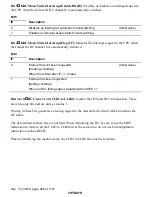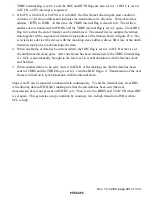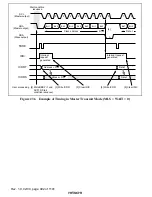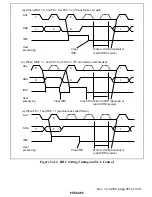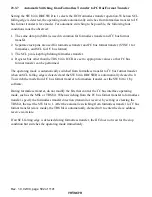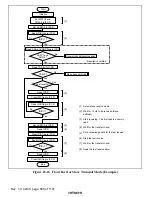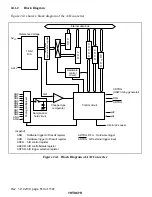
Rev. 1.0, 02/00, page 499 of 1141
23.3.5
Slave Transmit Operation
In slave transmit mode, the slave device outputs the transmit data, and the master device outputs
the transmit clock and returns an acknowledge signal. The transmit procedure and operations in
slave transmit mode are described below.
1. Set bit ICE in ICCR to 1. Set bits MLS in ICMR and bits MST and TRS in ICCR according to
the operating mode.
2. After the slave device detects a start condition, if the first frame matches its slave address, at
the ninth clock pulse the slave device drives SDA low to acknowledge the transfer. At the
same time, the IRIC flag is set to 1 in ICCR, and if the IEIC bit in ICCR is set to 1 at this time,
an interrupt request is sent to the CPU. If the eighth data bit (R/
:
) is 1, the TRS bit is set to 1
in ICCR, automatically causing a transition to slave transmit mode. The slave device holds
SCL low from the fall of the transmit clock until data is written in ICDR.
3. Clear the IRIC flag to 0, then write data in ICDR. The written data is transferred to ICDRS,
and the TDRE internal flag and the IRIC and IRTR flags are set to 1 again. Clear IRIC to 0,
then write the next data in ICDR. The slave device outputs the written data serially in step
with the clock output by the master device, with the timing shown in figure 23.11.
4. When one frame of data has been transmitted, at the rise of the ninth transmit clock pulse IRIC
is set to 1 in ICCR. If the TDRE internal flag is 1, the slave device holds SCL low from the
fall of the transmit clock until data is written in ICDR. The master device drives SDA low at
the ninth clock pulse to acknowledge the data. The acknowledge signal is stored in the ACKB
bit in ICSR, and can be used to check whether the transfer was carried out normally. If TDRE
internal flag is set to 0, the data written in ICDR is transferred to ICDRS, then transmission
starts and TDRE internal flag and IRIC and IRTR flags are all set to 1 again.
5. To continue transmitting, clear IRIC to 0, then write the next transmit data in ICDR. At this
time, the TDRE internal flag is cleared to 0.
Steps 4 and 5 can be repeated to transmit continuously. To end the transmission, write H'FF in
ICDR. When a stop condition is detected (a low-to-high transition of SDA while SCL is high), the
BBSY flag will be cleared to 0 in ICCR.


